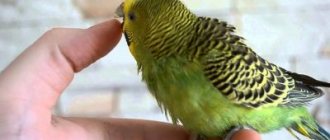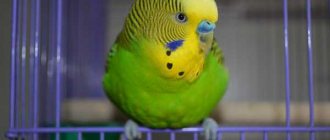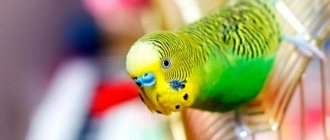- home
- Parrot
- FAQ
04/23/2019 Most varieties of parrots are recommended to be kept in pairs. Otherwise, there is a high probability that lonely birds will get bored, become depressed and begin to pluck out their feathers. But this recommendation also has pitfalls. Owners who follow maintenance rules and listen to advice often encounter unpleasant consequences in the form of fights and conflicts between cohabiting parrots. While sorting things out, the birds inflict injuries and mutilations on each other, which, of course, no owner will be happy about. For what reasons do parrots fight and how to prevent and correct it?
The female initiates the fight
Bird breeders can explain why fights break out between parrots. Almost always the initiator of the conflict is the female. It is she who will choose her soul mate and make claims to him in the form of fights.
Parrots, especially budgerigars, cannot exist without a pair. And even if the owner devotes a lot of time to his pet, the bird will still be depressed and melancholy. Therefore, the choice of a male should be taken with full responsibility.
The main thing is that the boy is older and larger than the lady. Then, feeling his superiority, the girl will not become aggressive. Even if the male is large, experienced, but young, the female will definitely feel this and show her character.
We need to put the couple in different cages for a while, maybe the lady will get used to it and stop plucking the feathers of her other half. If scandals continue, in order to avoid serious injury, it is better to look for another groom.
It happens when two adult women are put in a cage, then fights cannot be avoided. An exception will be if the females have grown together since childhood.
Release
Birds are born to fly. A pet parrot, confined to a cage, also wants to feel free. When the main stages of taming the cockatiel have been completed, you can allow it to go for walks. Before opening the door, the space needs to be secured as much as possible:
- remove animals;
- take out the plants;
- hide small items;
- close windows and doors.
Having prepared the room, they open the cage and try to lure the parrot out. One way is to bring your hand to the bird, and when it sits down, slowly pull it out. If the cockatiel is showing anxiety, do not rush it. You need to encourage your pet, and it will begin to flutter freely.
Attention! After a walk, the parrot must return to the cage on its own. You cannot drive it and catch it; it is best to lure it with the sound of pouring food - and the hungry bird will fly into its home. Taming a cockatiel is interesting and educational
Communicating with a smart bird, a person himself changes and discovers new abilities. Coercion and punishment are not the measures that should be used. Raising a bird requires love and patience.
Taming a cockatiel is interesting and educational. Communicating with a smart bird, a person himself changes and discovers new abilities. Coercion and punishment are not the measures that should be used. Raising a bird requires love and patience.
Hostility of a personal nature
There are also situations when everything is done as it should be and the male is good, but the parrots continue to fight until they bleed. This can be explained by only one reason - they have personal hostility towards each other.
You can try to prevent conflict by following some rules:
- A pair must be formed as early as possible. The younger the birds, the easier it will be for them to get along with each other;
- By nature, birds are very friendly. If they are kept in a cramped cage, conflicts may arise - they simply need a comfortable home. While the birds are younger, territory is enough for them. As they grow older, birds will need their own individual space. Therefore, the larger their personal home, the greater the likelihood that the couple will have peace and friendship;
- Everything that is in the parrots' home - toys, feeders and drinkers - must be in sufficient quantities for the pair. Each pet needs its own personal perch and favorite toy. Conflicts very often arise on this basis;
- Having brought another bird into the house, there is no need to immediately impose it on the second wavy. First you need to put the songbirds in different cages. It is necessary to let them out for a walk around the apartment at the same time.
- During walks, the parrots will get to know each other and make friends. Bring them together only when they begin to spend the night together in the same dwelling.
Why does a parrot become aggressive?
Often, parrot aggression is understood as the “running wild” of a tame parrot, which was previously very affectionate and willingly made contact with humans. At some point, such a bird begins to avoid a person, attacks the hand when they want to scratch the bird or simply change the food in the cage. This change in behavior is very typical for slowly maturing parrots, which include African Grays, Amazons, and Macaws. Since these birds mature at the age of 3 - 5 years, a person gets used to affectionate communication with the bird, and a sharp change in behavior is discouraging. This is a normal and inevitable process. It should be noted that in cockatoos this period of “growing up” can be completely disrupted due to the excessive imprinting of the chicks by the humans. Cockatoos are one of those species of parrots that take a very long time to train their chicks. Thus, according to the observation of Svetlana Gerova, the training of cockatoo offspring continues by “grandparents” for 5 or more years. It is interesting that if a chick is raised by a pair of parent birds that have a normal relationship with a person, then you can be sure that it will build a relationship with its owner similar to that of the parents, provided that the person does not try to make a “plush toy” out of the chick. Cockatoo chicks growing up with humans are deprived of examples of normal behavior, their self-identification is impaired, which ultimately leads to the fact that the birds are deprived of independence and dependent on human society. That is why there are many cases when a cockatoo cannot spend even 5 minutes without its owner, thereby making a person’s life unbearable. When the usual connection is disrupted (the owner changes or the person’s routine changes, the cockatoo develops psychosis. Such emotionally unstable birds can suddenly attack the owner or other family members, attack small children out of jealousy.
According to the observations of Lyudmila Tikhonova, chicks of Alexandrian parrots at the age of 4 months become “independent” - all previously learned commands are ignored and forgotten. Chicks are actively expanding the boundaries of their world, which can be fraught with collisions with adult birds when these parrots are kept in flocks. Young birds, without fear, bully adult parrots of their own and other species, and the owner of the birds must be constantly prepared to prevent “educational” fights. However, this applies to a greater extent to foster chicks that were raised together with the parent birds. Parrot chicks raised only by humans are infantile, inactive and often afraid of any unfamiliar object or movement.
What needs to be done to safely survive the period of “adulting” of the parrot?
- you need to prepare for this in advance - the sooner you start learning commands and tricks with the bird, the stronger physically, and therefore emotionally stable, the parrot will be by the time the time comes to become independent. Also, by this time a person will already understand the behavior of the bird much better, which will help in the future.
- you need to understand that now you are communicating not with a “child”, but with an independent adult bird, and from now on, communication with you is carefully evaluated by the bird; Roughly speaking, if the bird is not interested in you, you will only receive its attention as a source of food.
— you need to accustom the bird to the most varied diet from the first days of its appearance with you. The more varied a parrot's diet, the higher its cognitive abilities and level of interactivity. In other words, the more varied a parrot eats, the more curious it is and the less prone to psychosis and phobias.
This is important for the bird, which is beginning to build its relationship with the world around it in a new way.
— from the first moment of its appearance, you must teach the cockatoo to be independent and self-sufficient; you cannot stimulate the cockatoo’s excessive attachment to humans; you cannot stimulate and reinforce the hysterical behavior of the parrot (a variety of wild dances and games - videos of which are very popular on the Internet).
- there is no need to try to achieve compliance with all commands previously known to the bird; it makes sense to take a break from training and activities, leave the bird to its own devices and not interfere with the parrot.
Hormonal surges
A very common occurrence among same-sex parrots (males). They can coexist peacefully from early childhood. Having reached a certain age, conflicts and bloody fights begin.
The solutions are:
- For one month it is necessary to place them in different cages;
- Give only grain mixtures, slightly reducing the daily feeding rate;
- Make daylight hours shorter by covering the boys' homes with thick fabric.
After the 30 day period has passed, connect the males again. If the fights continue, it means that hormones are taking over and they begin to fight for primacy in the cage. Only one thing will help here - to finally settle the fighters in individual housing.
Why is this happening?
There are many reasons for children's pugnacity. This includes the age characteristics of twins, their temperament, the characteristics of their upbringing and many other factors.
Possible reasons
The main reasons for twin children fighting:
struggle for the love of parents; jealousy; fighting for toys, copying the behavior of parents (mother and father fight among themselves or physically punish children); boredom; one of the children has unfulfilled needs; different goals: one child wants one thing, another wants another; the difference in ways to achieve what they want - everyone wants to solve the situation in their own way; the parents have a favorite child (it is he who gets the lion's share of the warmth of mom and dad), another child tries to attract the attention of adults through fights.
Age crises
Age crises are unique stages of personality development. As a rule, during this period, conflicts with others are inevitable. The little man still does not fully know how to control his emotions, and the situation results in a banal fight.
There are several age-related features of the manifestation of childhood aggression:
- 6 months – 1 year. The first signs of aggression appear already in one-year-old children. Infants who cannot yet speak try to convey their thoughts to others by screaming and crying. If those around the baby do not understand, teeth or gums (if the teeth have not yet come out), or clenched fists can be used. At the same time, everyone can get “nuts” - both parents and brother/sister.
- 1-2 years. The baby has learned to walk or run, but along with the interesting world around him, he will have to get acquainted with a whole list of prohibitions and restrictions. The twins defend their dissatisfaction and the right to personal property (for example, toys) by shouting, throwing objects, pinching, and hitting.
- 2-3 years. At this age, children's speech and self-control are still very poorly developed. Communication skills are just beginning to develop, and children cannot clearly express their thoughts or explain their request in words. Under the influx of emotions, the kids begin to fight. At this age, children gradually strive for independence: they try to put on their own shoes, open a bottle, etc. Usually the little ones get very angry if something doesn’t work out for them. And if the brother and sister did better, there is no need to look for a greater reason for conflict. Battles for toys are becoming more and more relevant.
- 4 -7 years. Children after 4 years of age usually can speak coherently, so they can respond to anger or resentment verbally. The manifestation of aggression in four-year-olds is quite conscious; children gradually learn to control their emotions. Six-year-old children are on the verge of starting school. At this age, girls and boys react sharply to comments and can take any, even the most innocent, situation with hostility. Six-year-olds are sure that everyone around them, even their parents or siblings, is intent on harming them and not helping them at all.
- 8-10 years. After 8 years, aggressiveness gradually declines. Children learn to resolve conflicts verbally and reduce outbursts of anger to a minimum. The next stage is the teenage crisis.
Conflict between parents and children
Often fights between parrots (parents and children) can lead to murder. Therefore, it is better to prevent the problem and immediately after the birth of the offspring, place the babies in the brooder. Feed them from your own hands and keep the babies there until they fledge.
Why this happens is not fully understood. The birds may not have enough lighting, food or space. If the parents are too young, then they are not yet mentally ready for motherhood and fatherhood.
The fledgling chicks need to mature and grow up in order to be placed in the same home with their parents again. Living in one large company, adult females may begin to conflict without dividing the nest among themselves.
How to deal with a rooster pecking chickens
If you notice that the rooster is behaving too aggressively, attacking the chickens and trying to peck them, you need to take immediate action, as this can end in disaster
. It is important to understand why the rooster pecks the chicken and how to prevent it. In each herd there are several significant individuals who strongly support the rooster
If you notice that the rooster is behaving too aggressively, attacking the hens and trying to peck them, you need to take immediate action, as this could end in disaster
They help him peck the prey and drive it away from food. If you want to avoid problems, you need to temporarily relocate these birds to another place.
In small farms or household plots, the reasons for the aggressive behavior of a rooster may be psychological in nature. Most often, a rooster pecks a hen that has recently appeared in the flock. It cannot be placed separately, since after returning the weakened individual can be pecked to death. It is much more effective to remove the rooster from the enclosure. When you reintroduce him into the flock, the rooster will behave calmly and stop attacking the prey. If you notice that there is a conflict between the hens and the rooster, you need to react quickly and immediately begin solving this problem. This will allow you to maintain the flock and the health of the birds. The wisest thing to do is to play it safe and get rid of problem individuals right away.
Why do chickens fight?
What to do if parrots fight among themselves?
All pets need communication both between relatives and with the owner. Parrots are social creatures and require a lot of attention from their owner. If the bird is kept in individual conditions, then it can only communicate with its owner. When birds live together, both in pairs and among many relatives in a nursery, problems may arise that the parrots fight among themselves. What should the owner of the enclosure do in this case? It is necessary to understand the reason for this behavior and eliminate the provoking factor.
Hand Taming
Taming by hand is the final moment in the process of training a bird.
Before you begin taming, it is important to make sure that your pet is ready for training:
- Not afraid of a person approaching his home;
- Calmly sit on your hands within the cage;
- When flying out of the home, it calmly returns back after some time;
- While flying out of the house, it tries to sit on the head of the owner and other family members.
The main condition for training is friendliness and readiness for contact; it is forbidden to start training by forcing the bird to interact.
It is important to start the training process in the morning, before the bird has breakfast. The next stage must take place outside the cell. Before the pet begins to freely contact a person, it is necessary to teach the budgie to sit on a finger without fear, like on a perch in a cage.
To do this, just extend your finger to the parrot, he will quickly find his bearings and sit on it
Before the pet begins to freely contact a person, it is necessary to teach the budgerigar to sit on a finger without fear, like on a perch in a cage. To do this, just extend your finger towards the parrot, it will quickly find its bearings and sit on it.
Important Tips
When choosing where to purchase your pet, it is important to remember that birds from pet stores will be more difficult to train. This is due to the fact that budgerigars, living in a cramped cage in a store from birth, regularly experience stress. Knowledge of how to tame a budgie is not always enough for quick and effective training.
It is important to follow all the recommendations and subtleties in training this bird. Recommendations for taming a bird:
Knowledge of how to tame a budgie is not always enough for quick and effective training.
It is important to follow all the recommendations and subtleties in training this bird. Recommendations for taming a bird:
- Training should take place in the morning, when the pet is in a good mood;
- It is recommended to remove the feeder from the home at night, so the bird will be more willing to take food offered from your hands;
- Before training, it is prohibited to wash your hands using scented products or smear them with cream;
- The owner's hands should not have a strong tobacco smell.
Difficulties that may arise
The main difficulty that may arise during training is refusal to contact a person. But without communication, even the most fearful and cautious parrot cannot exist for long. The main thing in this case is to be patient, tune in to a longer period of taming and not make mistakes in training, after which the pet may become very frightened.
There are several training techniques when a pet categorically refuses to make contact:
- Offer him a toy, an imaginary friend that he can happily feed and care for;
- Place a mirror in the cage; parrots love to look at their reflection;
- Pull the toy out of the lid or ballpoint pen.
When training and feeding an individual from the palm of your hand, the parrot may fly out of its home. Another difficulty may be the pet’s reluctance to return to its cage. We need an effective and safe way to bring it back. The method is used after dark. It is necessary to remember the location of the individual and, with the light source turned off, in complete darkness, carefully pick it up and put it in the house
It is important to turn on the light only after the parrot is inside. After this, the bird will not be afraid of humans, this is due to the inability to see the parrot in the dark
What to do if parrots fight or rules for conflict-free living
The rules for the peaceful coexistence of parrots in the same cage include the following:
- Each bird in the cage should have personal space, expressed in the form of the necessary free space, its own feeder and drinker, separate toys and perches.
- The birds' nutrition must comply with the recommendations for the specific variety of parrots or breed.
- Feeders and drinking bowls should not be empty; feed should be added in time and water should be renewed.
- You cannot place a new parrot in the house of an old-timer immediately after acquisition. First you need to give the birds the opportunity to get to know each other from a distance. To do this, the birds are placed in different houses, which are placed so that the parrots are within sight of each other.
- You need to get a second parrot as early as possible. The less the first pet spends alone, the smaller the age gap between neighbors and the younger they are, the easier it will be for them to find mutual understanding.
- You cannot place two female parrots in one house.
Conflicts between parrots do not arise very rarely. If your pets start to quarrel, it is important to establish the cause as early as possible and try to solve the problem. If the recommended measures taken do not help, the birds will have to be housed in separate cages.
Amazon
This species includes 25 species that live in South and Central America. They are considered one of the best imitators of speech; they have a higher ability to imitate than the Gray Gray, although they are somewhat inferior in intelligence. They are affectionate to humans, have a friendlier character, and tolerate captivity well. On average, they can learn 80-100 words and also speak in short sentences. Amazon parrots can also perform simple circus tricks, reproduce the tones of musical instruments, whistle melodies, imitate animals and the sounds of nature.
These are one of the few parrots that do not hesitate to speak in the presence of a person and love attention to themselves. The best option for keeping in captivity are white-headed, yellow-winged, blue- and red-fronted, Brazilian and Venezuelan Amazons
conclusions
To summarize, the most important thing in this matter is that parrots must be of the same species; parrots of different species cannot live with each other. Also, these should not be two females; such a tandem will not lead to anything good. But this does not mean that two boys cannot get along with each other, they can, but girls cannot.
Parents and children must also live separately; a good option would be a boy and a girl of the same species. Also, do not forget about space and separate feeders for food and water. When there is a large space, the problems of parrots disappear. In this matter, the main thing is to understand the reason for the discord between your feathered pets. Show patience and care to your friends and everything will work out.
When parrots fight, the owner is obliged to find the cause of the aggression. Otherwise, the birds will hurt themselves and be in a bad mood all the time.
Source
What to do if parrots fight among themselves, what is the reason for this behavior
Most varieties of parrots are recommended to be kept in pairs. Otherwise, there is a high probability that lonely birds will get bored, become depressed and begin to pluck out their feathers. But this recommendation also has pitfalls. Owners who follow maintenance rules and listen to advice often encounter unpleasant consequences in the form of fights and conflicts between cohabiting parrots. While sorting things out, the birds inflict injuries and mutilations on each other, which, of course, no owner will be happy about. For what reasons do parrots fight and how to prevent and correct it?
Taming
The best option for a beginner in communicating with parrots is to buy a young parrot, which is much easier to make contact with a new person and can more easily tolerate a change of environment. All the stages of rapprochement described above will be easier for a young bird than if you began to tame an adult. So, the best way to get to know a young budgie is to talk, but only from afar. Your pupil will definitely become interested in you and will take a long and careful look at the new object, which also makes sounds. Another way to please this temperamental bird is to identify its favorite treat. But don't spoil her too much.
For example, if your bird is trainable and does what you ask of it, thank it by hand-feeding it its favorite treat. Let the young parrot get used to the fact that he only gets tasty things from your hands. First, push the treat through the bars of the grill, and after a while do this through the open door. Without the rods the level of trust will be much higher and the parrot understands this too. The next step is to offer this delicacy outside the cage, during a walk. For example, when a bird sat on your finger or actively played.
It will be more difficult to find a common language with an adult parrot. But it is more difficult in terms of time, because a mature bird tolerates a change of environment and new living conditions much more difficult. And to gain her trust, you will need a lot of time and patience. But the recommendations for taming remain the same. Not a single parrot has ever refused delicious food, games and walks.
Talk to him more often, show attention and play. And then even the most hardened character of the parrot will soften - and you will become friends
Is it possible to keep two Syrian hamsters? (in my case)
Good day:) A year ago I purchased a long-haired Syrian hamster (male) with a spacious two-story cage (46x30x54). Initially, they wanted to buy two males and put them in different cages connected by a tunnel. But we were convinced that this should not be done, since hamsters are territorial animals and will fight. We recently met a woman who has first-hand knowledge of breeding and keeping hamsters. She said that in her extensive experience, Syrian males (if they are in a spacious cage) do not fight, which cannot be said about females or the more aggressive by nature - Djungarians. And I myself very much doubt that our calm hamster, who is too lazy to even run in a wheel, will attack someone. But I don’t want to take risks (Maybe someone has kept two Syrian boys and can advise something?
if they are males, then they are the ones who are obligated to support you. give and take gifts to the Maldives at least 3 times a year
Please give shelter to a Syrian refugee, fellow countrymen.
I wouldn't connect adults. If you take two cubs, or even better from the same litter.
New features and design have appeared for the version of the Woman.ru Forum on computers. Tell us, what are your impressions of the changes?
We gave our son the same hamsters from the same litter, boys, the cage was spacious, but after 3 days they started to become aggressive and had to be separated.
I have been working with hamsters for 10 years. If you keep two males in the same cage, then they will not fight unless you pick them up and stroke them. If you do this, and I think you will play with them, then the group smell disappears and they begin to fight.











